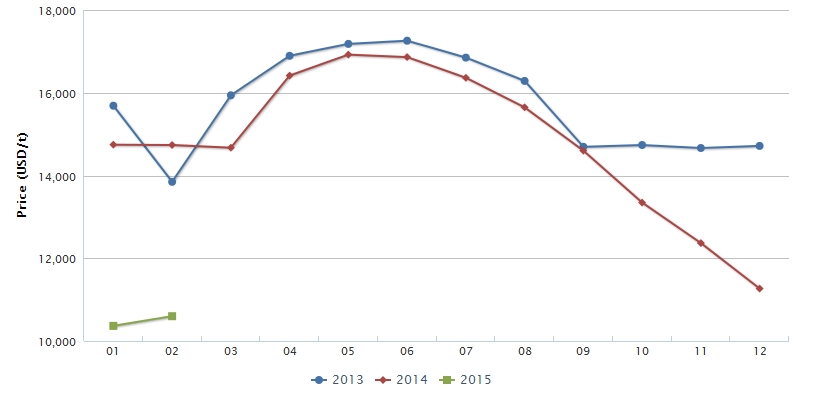Summary: The domestic market price of VE
continued to drop in 2015, because of the fierce industrial competition. It is
estimated that the price of V E will be kept at a low level or even to drop in
the short run while the price will be on the increase in the long run.
Starting from 2015, the price of vitamin E
(VE) continued to drop because of the overcapacity, the increasing supply and
weak demand from downstream industries. Based on the current market conditions,
the major domestic VE manufacturers will adapt different marketing strategies
which may influence the price of VE. It is estimated that the price of VE will
continue to drop in the short run while its price will increase in the long
run.
Market price of 50% powder feed grade VE in China, 2013-Feb. 2015

Source: CCM
Since 2015, the price of VE keeps dropping.
According to CCM's investigation, the market price of VE (50% powder feed
grade) was USD11,599/t in Feb. 2015, down by 30% compared with the figure
USD16,862/t in June 2014. The following three reasons could illustrate the
price drop.
1. Chinese VE manufacturers
launched price war. Starting from June 2014, Zhejiang Medicine Co., Ltd.
(Zhejiang Medicine) and Zhejiang NHU Co.,Ltd. (NHU) (the two biggest VE
manufacturers in China ) started a price war to fight with competitors and
improve their own market shares.
Even though the global VE industry has
overcapacity, more and more new entrants are attracted to enter this industry
for the high profit. They triggered price war. At present, the major VE
manufacturers in China are Zhejiang Medicine, NHU and PKU International
Healthcare Group (PKU). In the international market, the major VE manufacturers
are BASF and DSM. In fact, the capacity of the mentioned five manufacturers
could satisfy the demand from the world.
In 2014, the capacity of VE in the world
was 84,000 t/a while the demand for it was only 63,000 tonnes, indicating that
the overall capacity was 30% larger than its demand. Furthermore, Jilin Beisha
Pharmaceutical Co.,Ltd. (Jilin Beisha) built a new 9,000 t/a VE production
line, making the company's overall capacity of VE reaching 10,000 t/a. But, the
actual capacity of this production line was only 5,000 t/a-6,000 t/a because of
the high cost. This also could reduce the company's deficit.
2. The cost of VE dropped because
of the increasing raw material supply. Nenter & Co., Inc (Nenter) expanded
the capacity of 2,3,5-trimethyl hydroquinone (an important intermediate of VE)
to 80,000 t/a by the new technology. According to CCM's investigation, the
major VE manufacturers, Zhejiang Medicine, Zhejiang NUH and Jilin Beisha had
signed supply contract with Nenter.
3. The demand from downstream
industries was weak. The downstream livestock industry was in downturn, thus
their demand for VE was weak (feed industry consumes 80% of VE in China). Take
live pig farming as an example, data from the Ministry of Agriculture of the
People's Republic of China showed that the inventory of live pig in February
decreased by 3.9% month on month, down by 10.1% year on year; while, the
inventory of sow decreased by 1.9% month on month, 15.5% year on year. This was
lower than the warning figure 5% for 12 consecutive years. The demand for VE
from the sluggish live pig industry was weak. It is known that the annual
growth rate for the demand of VE (50% powder feed grade) was only between
2.0%-2.5%. The growth rate from demand lags behind the growth rate from supply
heavily.

It is noted that the operating profit for
the major three VE manufacturers dropped because of VE price drop. For example,
according to the annual performance report of NHU, the company's revenue and
net profit in 2014 was USD4.16 million (RMB25.52 million) and USD131.48 million
(RMB808.26 million), down by 1.7% and 8.4% year on year. Besides, Zhejiang
Medicine estimated that its net profit for the whole year of 2014 would
decrease by 55%-75% year on year and the figure in 2013 was USD73.54 million
(RMB452.10 million).
In 2015, the major VE manufacturers may employ different marketing
strategies. It is known that Zhejiang Medicine would continue to cut
down its sales price to compete with other competitors.
However, NHU and PKU may reduce
their production to ease the overcapacity of VE in the
global market, and to make the price rebound.
Their different marketing strategies would influence the price of VE. In
the short run, the price of VE may continue to drop. However, in the
long run, VE manufacturer's marketing strategies would push
up the price of VE.
About CCM:
CCM is the
leading market intelligence provider for China’s agriculture, chemicals, food
& ingredients and life science markets. Founded in 2001, CCM offers a
range of data and content solutions, from price and trade data to industry
newsletters and customized market research reports. Our clients include Monsanto,
DuPont, Shell, Bayer, and Syngenta. CCM is a brand of Kcomber Inc.
For more information about
CCM, please visit www.cnchemicals.com or get in touch with us directly by emailing econtact@cnchemicals.com or calling +86-20-37616606.